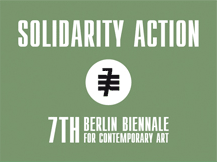1 Art should have an active role but in a capillary and organic way, in all the forms in which it manifests itself: from places of art education to those of information that instead of following fashions, the star system, televised spectacle and the monopolistic, globalized market, should be reinforcing diversity, independence of judgment, risk; to the institutional places of promotion and exhibition of art, placed at the service of a provincial internationalism that disguises the rule of capital; to the artists themselves, who are often incapable of reinventing a relationship with the society.
2 Today the negative effects of this situation have been consolidated: public structures without budgets to program their activities are transformed into boarding houses. The programs of public art spaces are determined by those who can afford the production costs of an art exhibition or an event.
3/6 In Italy the crisis has led to reflection on the concept of the common good: it has led to moments of gathering of artists, critics (I am thinking of the Commission for contemporary art – Consulta per l’Arte Contemporanea), companies and writers, who in assemblies at Teatro Valle, at the Cinema Palazzo Occupato and other places have begun to discuss their own roles as social categories, to reflect on their relationship with the institutions and places of education, and to think about the meaning of their work. The crisis has led us to reconsider the sense of belonging to a community and to make a commitment, in various ways, to defend cultural values and ideals acquired and conquered through struggles in the recent past. In general, it has encouraged forms of association, rationalization of resources, solidarity.
7 Interaction with institutions and their rules is inevitable for artists, critics and productive ensembles of different kinds. Independence is an exercise of resistance, of listening to one’s own voice and vocation. The pollution caused by favoritism on the part of the political system, the placing of the res publica at the service of private interests, individuals, profit or politics, are common practices in Italy, where the art system is not exempt from political divvying, oligarchies, concentrations and monopolies of power. Outside of these practices, the survival of one’s work is an exercise of day-to-day resistance. The attainment of a role of decision-making power in a cultural institution, in 90% of the cases, does not depend on professional and artistic qualifications, but on belonging to the ranks of one political side or the other. We should also consider the way independence is assimilated by the system, becoming a tactic for its very survival.
8 Cultural policy in Rome has been marked, in moments of political-financial impetus and investment, by a personalization of the cultural project on the part of the avant-garde administrator – the era of Renato Nicolini – that invested where success was predictable, and where the resources deployed could meet with guaranteed return in terms of image (in the center rather than the suburbs) and investment. The advisory commissions have only produced projects without concrete impact, and without economic resources (the suburbs and municipalities).
9 They are not so much manipulated as ignored in terms of their needs (residences, studios, places in which to develop their work in the proper conditions). Artists (musicians, actors, directors, sculptors, poets) find no welcome, no attention, no spaces for discussion of their proposals vis-a-vis the various directors who manage theaters or public art spaces. The res publica, the cultural and art institution, is governed by personal interests. Listening to the city and the lively forces that inhabit, express and reconfigure it in the various languages, is not an exercise put into practice by those who have roles of managerial power.
VALENTINA VALENTINI
Professor of Theory of the electronic image at La Sapienza University of Rome and at DAMS, University of Calabria.


